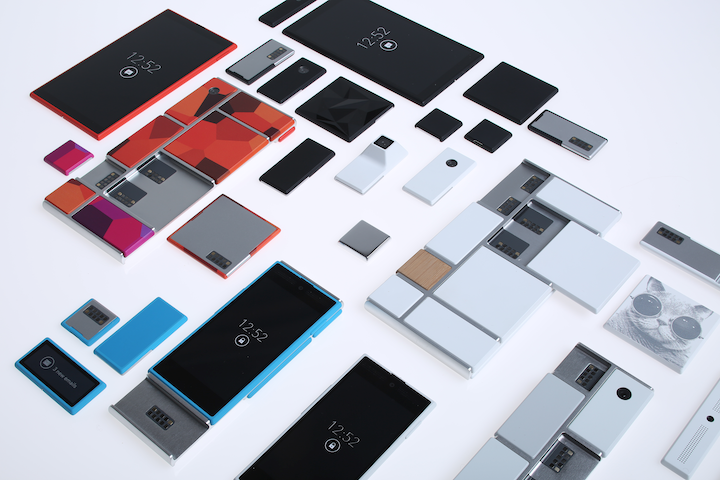What is Project Ara: When will it be released?
Google’s modular smartphone won't debut until 2016 now, but when is it coming and what will it be like?

When it comes to mobile phones, Google's focus has traditionally been on software, with its hardware involvement limited to working with phone manufacturers on its Nexus range of devices.
But now Google is ramping up its involvement in the physical-side of mobility Project Ara. This promises to make the smartphone modular, allowing users to have the phone they want without the bits they don't.
Plans for the project have been put on hold until 2016, despite originally being slated for testing and launch later in 2015. This is according to Project Ara's Twitter account, which confirmed the delay and attributed it to "lots of iterations... more than we thought".
What is a modular smartphone?
Smartphones tend nowadays to be monolithic, meaning that you can't even change the battery without an effort (we're looking at you Apple and Samsung!). Google wants to take this trend the other way and make a phone that is highly customisable, not only in terms of software but hardware as well.
Users would buy the frame or barebones of the phone and then add parts such as the processor, memory, storage, battery, and camera. The user chooses the parts they want in the phone rather than the manufacturer.
Also as better parts become available or parts stop functioning, it would be easy to swap these out rather than replacing the whole phone.
The phone could be the only one a user ever need to own (let's acknowledge here that the phone would very likely be like the Ship of Theseus in that once all parts have been replaced it wouldn't be the phone you had in the beginning).
Get the ITPro daily newsletter
Sign up today and you will receive a free copy of our Future Focus 2025 report - the leading guidance on AI, cybersecurity and other IT challenges as per 700+ senior executives
What is a Project Ara smartphone like?
The smartphones will be built by inserting modules into a metal frame known as an "Endo" or endoskeleton, which Google would make this frame and this would link all the other modules together. The frame is expected to cost around $15 to buy.
Two frames will be available; a "mini" and a "medium" frame. A "large" frame will be available in the future. The mini will be roughly the size of a Nokia 3310, the medium the size of an LG Nexus 5, and the large around the size of a Samsung Galaxy Note 3.
There will be a slot in the front for a display and various slots at the back for the individual modules, which will be hot-swappable so the phone can remain powered on (the frame sports a backup battery). Modules are said to be held in place with magnets.
According to this report from The Verge, the modules made holding the phone "feel a bit strange".
"Nothing rattled or slid out while we were playing around with it, though it's hard to tell how it will really work without the magnets," the report said.
How will people get parts for Project Ara?
The modules will be available from an official Google store or from third parties. Ara smartphones would only accept official modules by default, but like Android, a software setting can be change to allow unofficial modules.
Who is developing smartphones for Project Ara?
Project Ara is being developed by Google's Advanced Technologies and Products division (ATAP), which is headed up by ex-DARPA employees Regina Dugan and Paul Eremenko.
According a report from The Verge, ATAP uses the "DARPA model of innovation" which seeks to use new technology to pursue practical goals, rather than indulge in pure research or rehashing old ideas into new forms.
There are only a few permanent members of ATAP with outside contractors making up the bulk of the workforce.
ATAP has also been working with modular specialist Phonebloks to get the idea off the ground.
When and where will Project Ara be released? How much will it cost?
Google said at its first Project Ara developer conference that it planned to release the device in January 2015 with the base price of phone set at $50. This grey-coloured phone, known as "Spiral 2", sports 3G connectivity out of the box and is aimed at encouraging users to customising the handset.
The next generation, "Spiral 3", promises to use 4G/LTE connectivity as well as a host of other features.
The supposed January launch date has been and gone, and Google confirmed in August 2015 that the release has been postponed until 2016, saying on Twitter the delay is due to "lots of iterations... more than we thought".
Puerto Rico was chosen by Google as its trial city because around 77 per cent of the population uses the internet on their phones and also has a poor landline infrastruture, meaning most people use a mobile as their sole means of telecommunication.
Google said that the country is "a gateway from the US to the world".
"It is a bilingual culture. It is well-connected as a communications, logistics and trade hub. It has designated free-trade zones, which we can use for importing modules from developers worldwide," the company said.
What are the problems?
The main challenge seems to be Google getting this out of the door, with no release now due until some time in 2016.
Also, while the base phone is pretty cheap, the cost of the modules will soon rack up and users could end up with a DIY phone that is considerably more expensive than a normal smartphone.
With various manufacturers producing modules, there is also no guarantee that these will play together nicely, if at all.
Customers would also have to be mindful of the fact that certain combinations may not be optimal. A slow processor may not function well with a top-of-the-range display, while energy guzzling modules won't make for a good experience if paired with a poor battery.
Also, the modular design of the phone means it is likely not waterproof.
What other companies are involved?
Google has been working with Marvell and Nvidia to create a couple of reference designs for the phones. Toshiba is known to be building modules for the phone, including a set of processors and a 5-megapixel camera. Additionally, Yezz, a company that works exclusively on Project Ara, is said to be producing 20 or 30 modules for when the smartphone launches.
This article was originally published on 11/06/2015 and has been updated several times since (most recently on 18/08/15)
Rene Millman is a freelance writer and broadcaster who covers cybersecurity, AI, IoT, and the cloud. He also works as a contributing analyst at GigaOm and has previously worked as an analyst for Gartner covering the infrastructure market. He has made numerous television appearances to give his views and expertise on technology trends and companies that affect and shape our lives. You can follow Rene Millman on Twitter.
-
 Bigger salaries, more burnout: Is the CISO role in crisis?
Bigger salaries, more burnout: Is the CISO role in crisis?In-depth CISOs are more stressed than ever before – but why is this and what can be done?
By Kate O'Flaherty Published
-
 Cheap cyber crime kits can be bought on the dark web for less than $25
Cheap cyber crime kits can be bought on the dark web for less than $25News Research from NordVPN shows phishing kits are now widely available on the dark web and via messaging apps like Telegram, and are often selling for less than $25.
By Emma Woollacott Published

